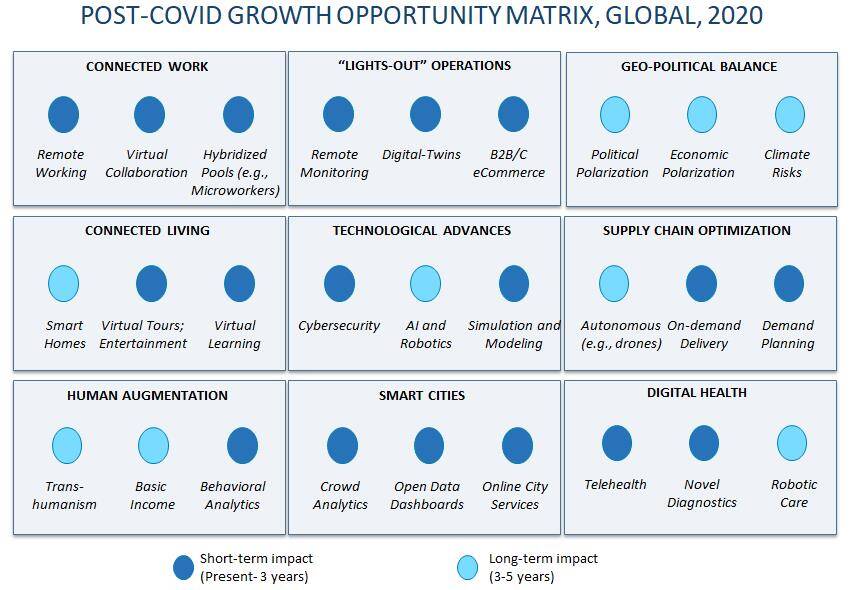No economy, industry or business has been spared from the effects of the novel coronavirus. Some industries have been affected more than others, and the impacts have been on a larger scale. It is fair to say that every industry is experiencing its unique set of challenges that are threatening their workflow and business models. Apart from the global pandemic, major economies have already experienced a slow down due to major additional factors causing a ripple effect to the world gross domestic product (GDP) decline.
Risk mitigation actions are key for survival and to better position ourselves at the point of recovery. In simple terms, crises like these require creative solutions; Frost & Sullivan has identified an exhaustive list of short- and long-term opportunities that will emerge from the reshaping of industries caused by the novel coronavirus.

The 9 key trends that will emerge from the Growth Opportunity Matrix include:
Connected Work: Reformed connected work scenarios will drive the need for cloud everything. New subscription-based models will witness a growing demand for UCaaS offerings that are enterprise-ready and can seamlessly integrate with existing legacy tools.
Lights-Out Operations: Autonomous “lights out” operations will drive demand for remote asset management solutions, and service providers will focus on data management strategies and data-driven business models.
Connected Living: An increased adoption of contactless surfaces post-pandemic will drive home automation and security markets. Systems encompassing voice activation technology will become increasingly popular among consumers. Smart home devices sales will see a 30% YoY increase for the fiscal year 2020.
Technology Advancements: Pandemic preparedness will speed up AI deployment and accelerate the pace of AI innovation. Between 32 million and 50 million US jobs could be increasingly assisted by technology to reduce health risks and safeguard productivity.
Supply Chain Optimization: Seamless integration of end-to-end digital supply chains will increase traceability, sustainability, and transparency within the supply chain ecosystem.
Human Augmentation: The adoption rate of customer behavior analytics by enterprises will grow by 20% for the period 2019-2025. Post-COVID, behavioral data will be used to enhance healthcare systems, financial services, and cybersecurity.
Smart Cities: Increased spending on technology by smart cities will lead to a surge in the adoption of digital tools like crowd analytics, and increased focus on developing digital platforms and apps for citizens.
Digital Health: Digital health driven by telemedicine and robotic care will become the new standard of care delivery. The standardization of service across the care continuum will require an increase in the number of service and technology providers.
Geo-political Balance: To protect themselves from economic fallout due to COVID, global organizations are coming together to restore geo-political and economic balance. Organizations like WHO, the UN and other public/private NGOs are working on rebuilding nations by ensuring that economic stimulus programs are prioritized.
COVID-19 has had an impact on multiple facets of our lives, including the way we work, conduct business or leisure. While some of these impacts have been shifting into major trends, the underlying technology transformation has been significantly accelerated. While this disruption has highlighted several gaps in the existing operating models, it also provides an opportunity to build more resilience in the system; this is where companies should strategize, build and grow in these times of adversity.
In the near term, companies should focus on diversifying the supply chain and leveraging new opportunities arising from changing customer demands. Over the long term, it is important to internally adapt to new technologies that support workplace and operational continuity to have a smoother transformation during recovery.
So, the question is, is your organization ready to embrace the “new normal?”
Listen to our on-demand webinar sessions where we discuss the key transformational themes that will emerge from these opportunities with relevant examples and companies to action. Explore the drivers and indicators associated with each opportunity, and what scenarios can emerge from them. Connect with us to know more about our Growth Opportunities Radar.
On-Demand Webinar: https://www.brighttalk.com/webcast/5562/421445
Frost & Sullivan’s recent analysis, “Reshaping of Industries Caused by COVID, Analysis of Critical Forces Shaping Growth Opportunities,” provides a detailed understanding of a post-COVID world. It acts as a best-practice guide for industry leaders seeking to understand the complex nature and impact of economic and industrial shifts and, accordingly, develop strategies to remain competitive over the next decade.
For further information on this analysis, please visit: https://www.frost.com/contact-us/



